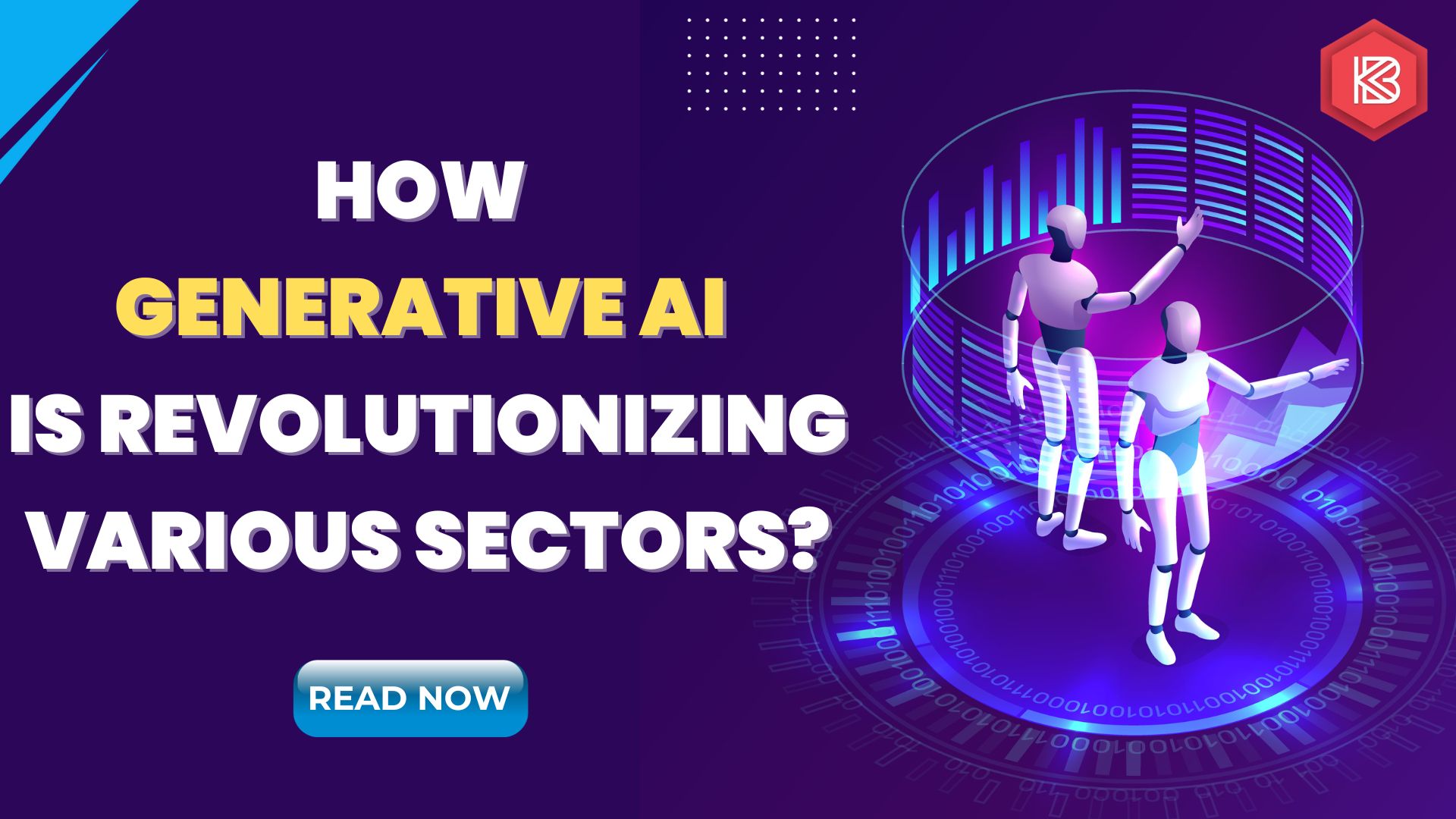How Generative AI is revolutionizing various sectors?

In the dynamic realm of technology, the emergence of generative artificial intelligence (AI) stands as a pivotal force transforming businesses across diverse domains. This cutting-edge technology harnesses sophisticated algorithms to produce text, images, and even code that closely resembles human creation, heralding a paradigm shift in industries and fostering novel opportunities. Delving into the profound influence of generative AI on enterprises, this article delves into its revolutionary impact on critical facets like operations, innovation, and customer engagement.
Various industrial landscape has undergone a remarkable metamorphosis in the past decade, transitioning from its deeply entrenched traditional roots toward a more automated and streamlined framework, epitomized by the era of Industry 4.0. With the advent of generative AI, the industrial sector witnesses a burgeoning array of possibilities, propelling transformative changes and ushering in a new wave of opportunities.
Comprehending Artificial Intelligence
Generative AI, a subset within the realm of Artificial Intelligence (AI), stands as an intriguing technology centered on content creation rather than conventional problem-solving or decision-making tasks. Here’s a comprehensive look into key aspects of Generative AI. This facet of Gen AI, abbreviated as Generative Artificial Intelligence, is dedicated to empowering machines to craft content, data, or even responses akin to human-like output.
Its defining trait lies in its capacity to generate original content, diverging from reliance solely on existing data or patterns. Utilizing neural networks, particularly generative models, it excels in producing content of remarkably human-like quality.
Fundamentally, Generative AI revolves around the education of machines to exhibit creativity, innovation, and a semblance of independent thought, although within the constraints and data it has been trained upon. This marks a notable departure from conventional AI, which primarily revolves around pattern recognition and data analysis.
How is generative AI established?
Generative AI initiates with a prompt, encompassing text, images, videos, designs, musical notes, or diverse inputs interpretable by the AI system. Various AI algorithms then generate fresh content in reaction to this prompt, ranging from essays to problem-solving solutions or convincingly realistic creations sourced from images or audio samples.
Earlier iterations of generative AI necessitated data submission via APIs or intricate processes, mandating developers to acquaint themselves with specialized tools and code applications in languages like Python.
However, forefront innovators in generative AI are pioneering enhanced user experiences, allowing users to articulate requests in plain language. Beyond the initial response, users can further tailor results by offering feedback on the desired style, tone, and other elements, refining the generated content to align more precisely with their preferences.
How Generative AI Differs from Other AI Models?
To understand Generative AI better, it’s essential to differentiate it from other AI models. In traditional AI, models are designed for specific tasks, such as image recognition or language translation. While these models thrive within set roles, they lack the adaptability and versatility inherent in Generative AI.
Generative AI models, on the other hand, are designed to be creative and adaptable. They are exceptionally versatile and able to produce text, graphics, music, and more. Instead of merely relying upon structured data, they extract conclusions based on large datasets and thereafter generate content that adheres to the trends they have discovered. Because of its flexibility, generative AI has reshaped a number of industries.
What perks could generative AI offer?
Generative AI holds broad applicability across various business domains, simplifying content comprehension and automatic content creation. Developers actively investigate its potential in streamlining workflows and aim to entirely transform existing processes to harness its capabilities. Key advantages of integrating generative AI encompass enhanced content interpretation, seamless content generation, and the potential for workflow optimization.
- Streamlining manual content creation processes.
- Minimizing email response efforts.
- Enhancing replies to technical queries.
- Generating lifelike personifications.
- Condensing intricate data into cohesive narratives.
- Facilitating style-specific content creation.
Future prospects for generative artificial intelligence
The extensive capabilities and user-friendly nature of ChatGPT have propelled the widespread embrace of generative AI. However, this rapid uptake has highlighted challenges in responsibly deploying this technology. These initial hurdles have spurred research into improved detection tools for AI-generated content—text, images, and video.
The popularity of tools like ChatGPT, Midjourney, Stable Diffusion, and Bard has sparked a myriad of training courses catering to diverse expertise levels. Some target developers crafting AI applications, while others cater to business users seeking enterprise-wide integration.
Eventually, industry and society will collaborate to develop robust tools for tracking information provenance, fostering more trustworthy AI systems.
Generative AI’s evolution promises strides in translation, drug discovery, anomaly detection, and the creation of varied content, spanning text, video, fashion design, and music. While standalone tools excel, the true future impact lies in seamlessly integrating these capabilities into existing tools. Expect grammar checkers to enhance, design tools to seamlessly embed richer suggestions, and training tools to identify and share best practices efficiently across organizations.
These changes are just the tip of the iceberg in how generative AI will reshape near-term workflows. Forecasting its future impact remains challenging, yet as we continue leveraging these tools to automate and amplify human tasks, reevaluating the essence and significance of human expertise becomes inevitable.
Various industries that are impacted by generative AI
Healthcare- Improving Medical Diagnosis and Treatment
Generative AI in healthcare leverages neural networks and computer vision, improving data analysis for precise diagnoses and care.
Enhanced medical image analysis – Generative AI’s precision in scrutinizing medical images like X-rays, CT scans, and MRIs assists in detecting nuanced abnormalities, enabling early and precise diagnoses of conditions often missed by human observation.
Advancing Drug Discovery – Generative AI accelerates drug discovery for pharmaceutical firms by producing molecular structures, introducing innovative therapeutic options, and broadening treatment horizons across diverse diseases.
Sector of Financial Services: Prudent Predictive Modeling
Generative AI revolutionizes the financial domain by elevating predictive modeling, enabling data-driven decisions for informed investments and risk management.
Evaluation and forecasting of risks – Leveraging generative AI for data-driven decision-making, financial institutions bolster investment decisions and risk management, yielding mutual benefits for businesses and their clientele.
Fraud detection and avoidance – Through ongoing transaction surveillance, generative AI facilitates rapid detection and alerts regarding suspicious activities, safeguarding financial institutions and clients against fraudulent behavior.
Advertising and Marketing: Customized Engaging
Generative AI is revolutionizing advertising and marketing, empowering personalized audience targeting through innovative tools in digital campaigns.
Individualized content production – Utilizing generative AI, content is customized to specific user tastes, amplifying advertising personalization, boosting customer engagement, and refining targeting strategies for greater effectiveness.
Content creation and ad formulation – Generative AI empowers advertisers in composing ad copy and creative content. Automated creativity generates impactful, audience-specific messages, elevating click-through and conversion rates for targeted resonance.
Advertising and Production of Content
In the telecom sector, Generative AI influences content creation and advertising. Providers utilize AI for tailored marketing content, reflecting user preferences. This customization elevates ad effectiveness and engagement. AI streamlines web and social content production, conserving time and resources. Adopting Generative AI yields innovation, efficiency, enhanced services, workforce productivity, and heightened customer satisfaction, culminating in a substantial competitive edge.
Generative AI transforms telecom by refining connectivity, customer experiences, security, and content creation. Embracing AI-driven innovations is pivotal for providers’ competitiveness in an evolving digital realm.
Creative Arts: Altering the Boundaries of Art
Generative AI sparks a creative renaissance for artists and designers with tools like Adobe’s Firefly and Photoshop’s AI Generative Fill, enabling unique and captivating artistic expressions.
Automated creation of artwork – Artists harness autonomous Generative AI tools such as DeepDream and Runway ML to create elaborate digital art. These tools act as foundational canvases for refining creative visions.
Inspiration for designs – Innovative Generative AI models such as VQ-VAE-2 or StyleGAN provoke fresh design ideas, encouraging artists to transcend conventional limits and explore unimagined concepts.
Creation of patterns and styles – Generative AI explores diverse patterns, artistic styles, and emulates renowned art movements, offering artists opportunities to experiment with visual languages and foster creative expansion.
Conclusive thoughts
Generative AI reshapes industries, optimizing operations, fueling creativity, and enhancing customer interactions through efficient data-driven decisions. Embracing this advancing technology can grant businesses a competitive edge and spur innovation. However, ethical considerations, data privacy, and human oversight are crucial for its responsible use. Representing a milestone in AI evolution, generative AI holds the potential to redefine business landscapes, demanding adaptability for those seeking forefront positions.
This transformative force revolutionizes content creation, data augmentation, and personalization, reshaping business operations and innovation. Staying ahead in its development is essential in this evolving landscape. Businesses seeking to leverage its potential benefit from diverse generative AI development services, including custom model creation and integration consulting. Notably, Kryptobees a leading AI Development Company stands as a prominent partner, offering tailored solutions through expert generative Artificial intelligence development. Their team empowers organizations to automate content generation, elevate data quality, and pioneer industry innovation.
Collaborating with Kryptobees a prominent AI development company in generative Artificial intelligence development unlocks new avenues for businesses, fostering streamlined operations and groundbreaking innovation. As generative AI progresses, Kryptobees remains at the forefront, empowering businesses to thrive in a generative AI-driven future.
 Discuss Project!
Discuss Project!